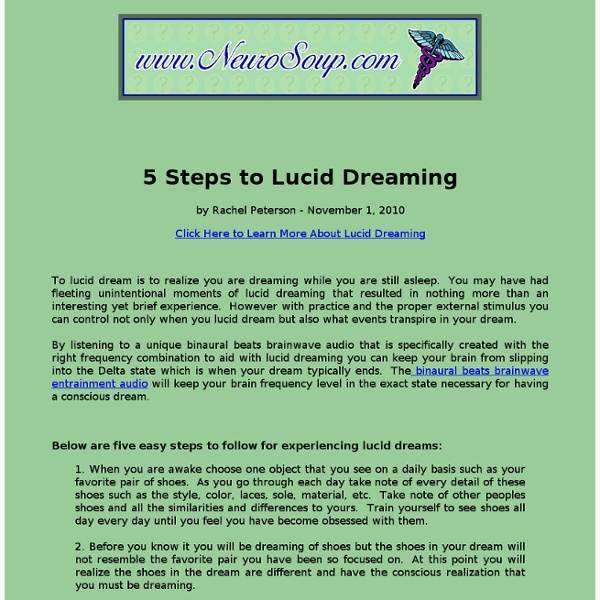



http://www.neurosoup.com/5_steps_to_lucid_dreaming.htm
Related: jessroeThe Personality Project Welcome The personality-project is a collection of web pages devoted to the academic study of personality. It is meant to guide the interested student, researcher or serious layperson to recent developments in the field of personality research. Included in the personality-project web pages are historical reviews of the field, links to current research findings from around the world, course syllabi on personality as well as on research methodology with a particular emphasis upon psychometric research, and tutorials to help everyone learn some of the more powerful statistical procedures used in personality research. Some pages are very technical, some are not. Some are very new, some have not been updated in several years.
Lucid Dreaming/Induction Techniques This page describes a number of lucid dream induction techniques. It is recommended that you be able to recall at least one dream per night in order to maximize the effectiveness of these methods. Preliminary Knowledge[edit]
Lucid Dreaming Techniques: A Guide To Lucid Dream Induction Here are my top lucid dreaming techniques for beginners. They range from simple memory exercises (like Reality Checks and Mnemonic Induction of Lucid Dreams) to specialized meditation (like Wake Induced Lucid Dreams). Lucid Dreaming Tutorials For step-by-step tutorials and audio tools for lucid dream induction and exploration, check out my Lucid Dreaming Fast Track study program for beginners and beyond. 52 Ways to Have Lucid Dreams
Portrait of an INFP As an INFP, your primary mode of living is focused internally, where you deal with things according to how you feel about them, or how they fit into your personal value system. Your secondary mode is external, where you take things in primarily via your intuition. INFPs, more than other iNtuitive Feeling types, are focused on making the world a better place for people. Their primary goal is to find out their meaning in life. What is their purpose?
Living Inside Your Dreams: Astral Projection Dream Awareness, Lucid Dreaming and Astral Projection By Robert Zucker "Living Inside of Your Dreams" is a condensed version of two manuscripts developed during a college independent study in the late 1970s. The subjects of dreams, hermetics and cultural similarities were explored. Hundreds of pages were condensed from thousands of pages of notes. The University of Arizona department of Anthropology, Journalism, Judaic Studies, Psychology and Sociology provided sponsorship for three years to allow me to compile this massive information. How To Stay Lucid in Dreams and Increase Dream Intensity This article will teach you exactly how to stay lucid in dreams - transforming a few brief seconds of lucidity to many long, memorable lucid experiences. I have included a number of dream stabilizing techniques below, based on Dr Stephen LaBerge's lucid dreaming experiments and my own personal experiences. My first lucid dreams were very short - we're talking seconds. I would realize I was dreaming and run around telling everyone about it.
Portrait of an INTP As an INTP, your primary mode of living is focused internally, where you deal with things rationally and logically. Your secondary mode is external, where you take things in primarily via your intuition. INTPs live in the world of theoretical possibilities. They see everything in terms of how it could be improved, or what it could be turned into. Lucid Dreaming is an Ancient Practice Introduction Lucid dreaming was taken very seriously by some cultures during ancient times. For example, in the 8th Century, TheTibetan Book of the Dead described of a form of Yoga designed to become conscious while dreaming. Yoga of the Dream State “Milam,” the Yoga of the Dream State is one of many different types of Yogas practiced by Tibetan Buddhists. The intention of this form of Yoga is to help to attain spiritual power and enlightenment or “awakening.” The word “Buddha” means “one who has awakened.”
How To Avoid These Two MAJOR Lucid Dreaming Mistakes!! A question I got which touches on two common mistakes: You know when you say I am supposed to stay awake and convince my body to go to sleep. First of all once I roll the whole lead blanket feeling vanishes. And then I will try to keep my mind awake and resist the movement urges but my body just won’t switch off, all I get is headaches. A lot of people wonder, why does “stop, drop and roll” involve moving your arms and rolling over if the whole trick to getting into waking sleep paralysis is to stay perfectly still? A Brief History of Psychology If you're taking an introductory psychology course this semester, you're likely in for a crash course in what psychologist Hermann Ebbinghaus called psychology's long past and short history. While the underpinnings of the discipline date back thousands of years, psychology did not emerge as a separate field until the founding of Wilhelm Wundt's lab at the University of Leipzig in 1879. Since that time, psychology has undergone dramatic changes and transitions, with numerous theoretical views arising and vying for dominance. In order to understand the wide range of topics studied by modern psychologists, it is important to understand a bit about past thinking and research. You can brush up on your knowledge and get a quick overview in this brief history of psychology. Related Reading
Lucid Dreaming/Introduction Disclaimer[edit] When attempting some of the techniques in this book, you may have some frightening experiences, such as falling sensations or sleep paralysis. Although the authors attest these are not dangerous, you should avoid techniques that create these sensations if you would prefer not to experience them. Your own expectations will have a significant effect on your dreams.